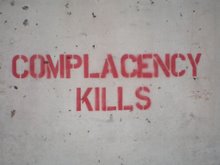Nothing right now. One of the things that I've been cautious about is allowing statistics to sway my opinion on the status of the war. Neither an increase nor a decrease in casualties determines the status of the war. Neither do increases or decreases in attacks. Not in terms of trying to compare them from any period over the last four months or four years.
Major attacks decline in Iraq h/t Ace of Spaces
One of the reasons that the main stream media is slow to take this up is the same reason that I am reluctant to use it as a measurement for success. Largely because we have heard and seen these decreases and increases over many different periods of time. It often reflects when we have picked up our operational activities. But, it has also reflected different realities of fighting in a desert country with high temperatures and a society that is still tied closely to agriculture and animal husbandry. Even the United States has planned invasions of Iraq around known weather patterns and seasons.
I have no idea where the data comes from for the "50%" drop, but the Brookings Institute index, that I have reviewed in past periods and that has sometimes been used to reflect one political idea or other about the status of Iraq, does not really reflect that decrease. There must be data from the military or other organization that reflects this change.
Some things that might skew current number are seasonal and cultural considerations.
This is not simply related to our efforts, but are directly related to how the insurgents conduct their operations. Some of which is dictated by the weather. throughout the last four years, attacks have spiked in late spring as the weather has warmed and the rains that make the terrain difficult have decreased. Then, through mid to late summer, the attacks taper off. Largely because it is simply too hot to conduct operations, even at night. They pick up again towards mid fall when the weather is cooler and the rains have not begun. There is the months of Ramadan where everybody has a long vacation and it gives the part time insurgents time to participate more fully.
Then you have the overlying issue that Iraq has a large part of its population involved in agriculture and animal husbandry. The cycles of planting and birth also predict upticks in attacks based on availability of personnel to carry them out. (keeping in mind that early spring is time for planting and when lambing is most prevalent and early fall is also the beginning of harvesting foods, culling herds and breeding the remaining herd for the following spring).
The final tally for the year and subsequent comparison does not represent any real intelligent data that we can base "winning" or "losing" on. In fact, during a recent argument with an "escalation of war" alarmist, I pointed out that all wars have escalated more towards the end with more deaths than at the beginning. That is in classical warfare and counter-insurgency. That is typically how one armed force defeats another.
The real question will be whether the Ramadan period and next spring offers the same kind of conflict or whether it drops off to near nil. The number of attacks today are significant only to the point that it indicates our interdiction and harassment operations along with COIN are successful in interrupting their current operations. Will it significantly decrease their future capabilities? We won't know until the future of course.
In short, these numbers mean nothing until it is a sustained decrease in deaths and wounding of Iraqis and Coalition and a requisite increase in economic indicators.
Read also:
Mike Yon: Three Marks on the Horizon
Ligers
Ashes and Dust
H/T Mudville
Tuesday, August 14, 2007
Major Attacks Down 50% in Iraq: What Does It Mean?
Posted by Kat at 2:09 AM Tweet
Labels: Iraq, Troop Surge, War
Subscribe to:
Post Comments (Atom)




















No comments:
Post a Comment